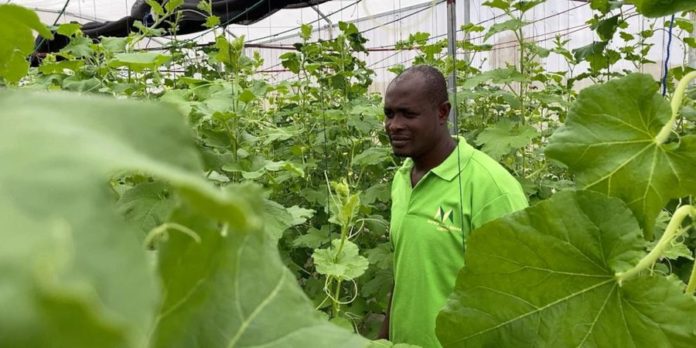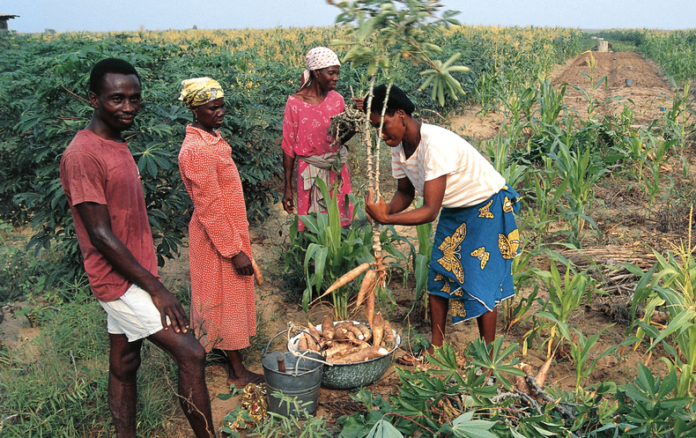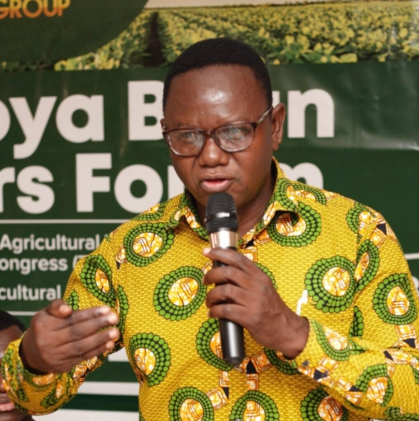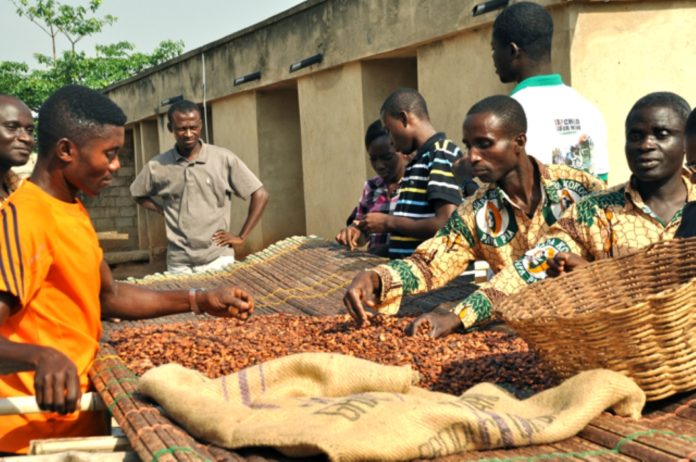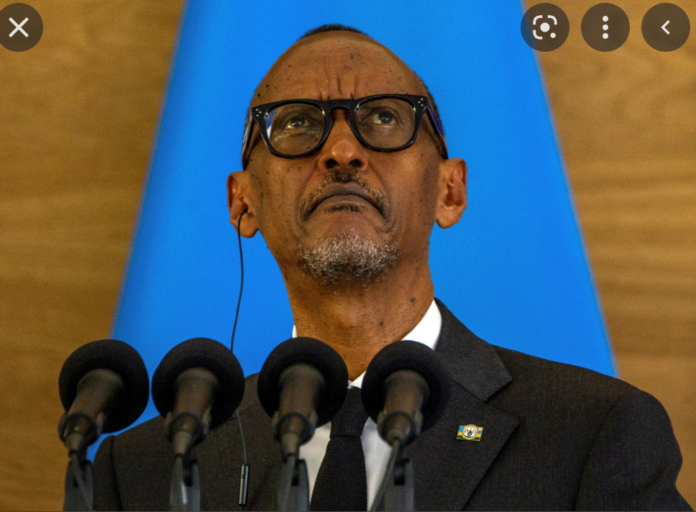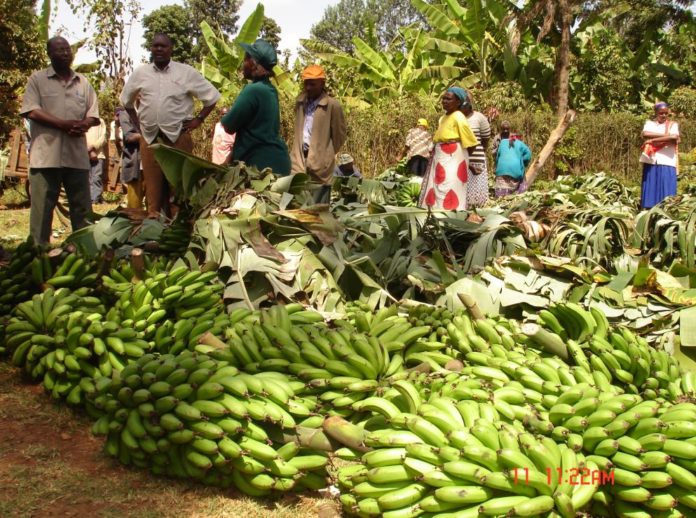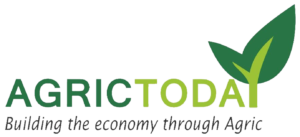Ghana-based agribusiness company Maphlix Trust exports vegetables to markets such as the UK and Dubai and also supplies local companies like KFC and Shoprite. Jeanette Clark talks to founder and managing director, Felix Kamassah, about how he secured international clients, local import substitution opportunities, and why he sees potential in the processing of sweet potatoes.
Champions Dishes at Adabraka, 2 other businesses faulted by GRA for failing to issue VAT invoices.
The Ghana Revenue Authority (GRA) on Thursday arrested some management members of three businesses in Accra for failure to issue Value Added Tax (VAT) invoices.
A project to empower farmers to increase income, food security, and food safety amid a changing climate launched.
A new programme to support farmers to improve food security and protect livelihoods has been launched
GAWU warns of abject poverty and food insecurity among farmers in the north.
The General Agricultural Workers Union is warning of abject poverty in farming communities up north.
According to the General Secretary, Edward Kareweh, his outfit’s investigations in some rural areas up north indicates that the unavailability of fertilisers and other farm inputs like seeds and equipment are likely to hamper the expected produce to be harvested.
To this development, Edward Kareweh, warns if the situation is not addressed immediately it could spell doom for the country’s food security.
His comment follows assertions by the Minister of Food and Agriculture, Dr. Owusu Afriyie Akoto that a ¢2.6 billion investment made by the government into the ‘Planting for Food and Jobs’ Programme has yielded expected results.
Speaking to Joy Business, Edward Kareweh, pointed out that the statement by the Minister is not the reality on the grounds as there seems to be a looming danger ahead.
“I am on the field, I am taking a tour of the three Northern Regions because as I consider them so. I have gone to the rural areas and am telling you that there is going to be abject poverty in 2023 because there is a lack of inputs”.
“You know, no fertiliser the inputs he’s talking about that is seed and fertiliser. I have gone to the villages and I am now in the Upper East Region, I have finished with the Northern Region not only in the cities but in the rural areas”, he added.
He expressed worry “we are not also relying on figures only. Look, you go on the grounds and see people’s lives are at stake. You know it has to do with lives, if you have 50,000 of your people who are starving of poverty of food, you must be concerned about that and that is the reality on the ground”.
Yara says to halt the Belgian fertiliser unit in the coming days.

Norway’s Yara (YAR.OL), one of the world’s largest fertiliser makers, said on Tuesday it will halt output at its Belgian unit “in the next few days”, as part of a wider European reduction plan linked to soaring gas prices.
Ghana’s economy grew faster than expected in manufacturing, Cocoa.
• GDP expanded 4.8% in the second quarter; the median estimate was 2.7%
• Ghana targets annual economic growth of 3.7% this year
Ghana’s economy grew faster than expected in the three months through June, expanding 4.8%, buoyed by manufacturing and cocoa production.
The median of five economists’ estimates in a Bloomberg survey was for a growth of 2.7%. Yields on Ghana’s dollar bonds were little changed after the release of the data, with the government’s budget targets seen as increasingly attainable. The economy grew 1.1% from the previous quarter.
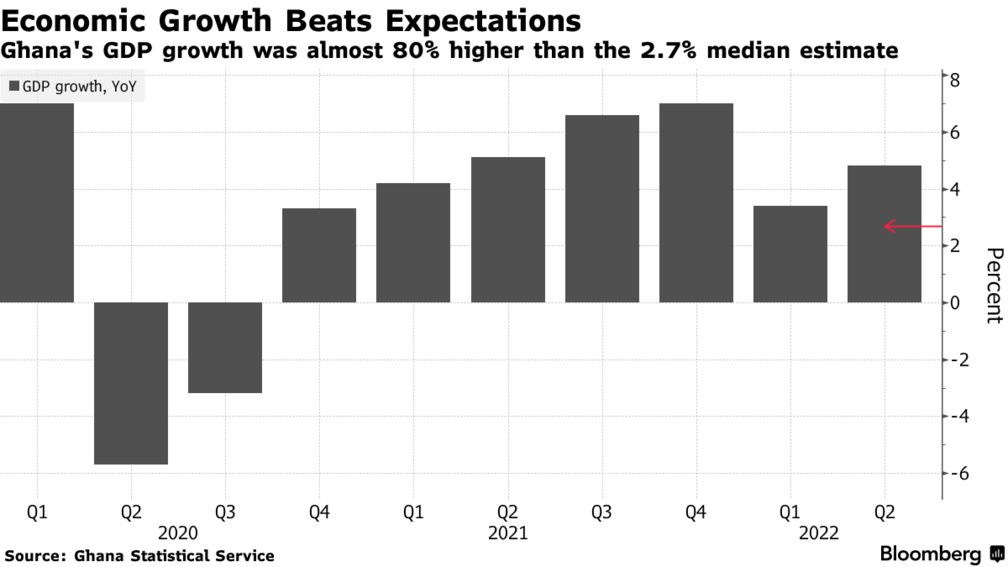
Manufacturing was one of the main drivers of growth, along with cocoa production, Government Statistician Samuel Kobina Annim told reporters in the capital, Accra, on Tuesday. Ghana is the world’s second-biggest producer of chocolate-making ingredients after the Ivory Coast.
The industry sector accelerated to 4.4% from a year earlier, compared with a 0.5% contraction in the previous quarter, expansion in the agriculture sector slowed to 4.6% from revised growth of 5.1%, and services gained 5.2% from 5.6%.
The yield on Ghana’s dollar bonds maturing in 2032 widened by 5 basis points to 24.8% at 11.15 a.m. in Accra.
The pick-up in growth momentum will likely improve West Africa’s second-largest economy’s chances of reaching its expenditure and revenue targets. The finance ministry in July cut its growth forecast for 2022 to 3.7% from 5.8%. The median estimate of seven economists polled by Bloomberg last month is for an expansion of 3.9%.
Economic growth may be lackluster in the second half of the year due to weak private consumption, Mark Bohlund, a senior credit research analyst at REDD Intelligence said ahead of the release. Business conditions deteriorated for the seventh month and are at their worst level since the height of the pandemic as price pressures continued to weigh on demand, the S&P Global Ghana Purchasing Managers’ Index shows.
Inflation is at its highest level in 21 years, fanned by a 39% decline in the value of the cedi against the dollar. This prompted the central bank to raise the benchmark interest rate by 850 basis points in November, the steepest margin since the central bank was granted the independence to set borrowing costs in 2002, dampening consumer spending and deepening poverty.
Adverse economic conditions led the government to approach the International Monetary Fund in July for a $3 billion economic-support program. The lender is due to make a follow-up visit to Africa’s second-largest gold producer in the coming weeks.
Organic farming offers a path to reducing external shocks on food – President Paul Kagame.
A fertiliser boom is breaking out across Africa as calls for food security gain momentum amidst a widespread continental food crisis.
Safeguard Ghana’s reputation: Agric Minister to Agric students to study in Israel.
The Minister for Food and Agriculture, Dr Owusu Afriyie Akoto has admonished students from agricultural institutions and universities embarking on an internship programme to Israel to work hard and protect the country’s image.
He advised the students to stay true to the programme and not abscond when they get to Israel but use the opportunity given them to work hard and establish themselves on their return to Ghana.
He made this comment at an orientation session for Agric students selected for an 11-month intensive practical agricultural training.
As part of the programme, students would visit farmlands and other agricultural establishments in Israel to learn practical knowledge of the Israeli agriculture system.
Agrostudies is an Israeli programme which offers apprenticeship that focuses on agriculture capacity building and promotes food security.
The exchange programme forms part of the government’s move to modernize agriculture and boost the sector for sustainable growth.
The exchange programme is a collaboration between the government of Ghana’s Ministry of Food & Agriculture and the State of Israel’s Ministry of Foreign Affairs.
As part of the exchange programme, the beneficiaries will be paid a monthly allowance which they are expected to save to enable them to kick start their own Agribusiness upon their return
Planting for Food and Jobs Programme has failed – GAWU takes a jab at Agric Minister.
The General Agriculture Workers Union (GAWU) has taken a swipe at the Minister of Food and Agriculture, Dr. Owusu Afriyie Akoto, over assertions that the ¢2.6 billion injected into the Planting for Food and Jobs Programe has yielded the desired results.
There is enough food in the country – the Association of Concerned Farmers has assured.
The Association of Concerned Farmers has assured the general public that there is enough food in the country. This was said after the association embarked on an initiative dubbed; “identification of community challenges”, where they toured farming communities to engage farmers following complaints from the public about the increasing prices of food in the country.

